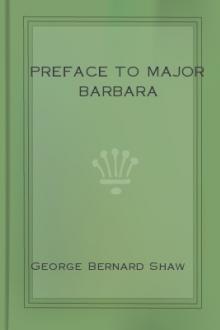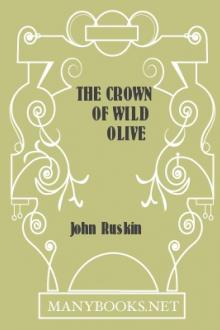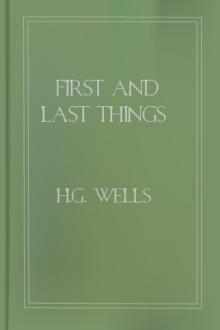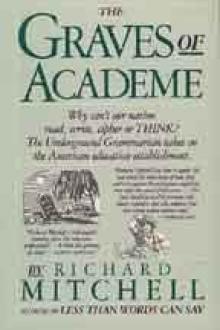The Queen of the Air, John Ruskin [classic novels for teens .TXT] 📗

- Author: John Ruskin
Book online «The Queen of the Air, John Ruskin [classic novels for teens .TXT] 📗». Author John Ruskin
Alas, we have most of us to walk bare-headed; but that is the meaning of the story of Nemea,--worth laying to heart and thinking of sometimes, when you see a dish garnished with parsley, which was the crown at the Nemean games.
How far, then, have we got in our list of the merits of Greek art now?Sound knowledge. Simple aims. Mastered craft. Vivid invention. Strong common sense. And eternally true and wise meaning.
Are these not enough? Here is one more, then, which will find favor, I should think, with the British Lion. Greek art is never frightened at anything; it is always cool.
It differs essentially from all other art, past or present, in this incapability of being frightened. Half the power and imagination of every other school depend on a certain feverish terror mingling with their sense of beauty,--the feeling that a child has in a dark room, or a sick person in seeing ugly dreams. But the Greeks never have ugly dreams. They cannot draw anything ugly when they try. Sometimes they put themselves to their wits'-end to draw an ugly thing,--the Medusa's head, for instance,--but they can't do it, not they, because nothing frightens them. They widen the mouth, and grind the teeth, and puff the cheeks, and set the eyes a goggling; and the thing is only ridiculous after all, not the least dreadful, for there is no dread in their hearts. Pensiveness; amazement; often deepest grief and desolateness. All these; but terror never. Everlasting calm in the presence of all fate; and joy such as they could win, not indeed in a perfect beauty, but in beauty at perfect rest! A kind of art this, surely, to be looked at, and thought upon sometimes with profit, even in these latter days. To be looked at sometimes. Not continually, and never as a model for imitation. For you are not Greeks; but, for better or worse, English creatures; and cannot do, even if it were a thousand times better worth doing, anything well, except what your English hearts shall prompt, and your English skies teach you. For all good art is the natural utterance of its own people in its own day.But also, your own art is a better and brighter one than ever this Greek art was. Many motives, powers, and insights have been added to those elder ones. The very corruptions into which we have fallen are signs of a subtle life, higher than theirs was, and therefore more fearful in its faults and death. Christianity has neither superceded, nor, by itself, excelled heathenism; but it has added its own good, won also by many a Nemean contest in dark valleys, to all that was good and noble in heathenism; and our present thoughts and work, when they are right, are nobler than the heathen's. And we are not reverent enough to them, because we possess too much of them. That sketch of four cherub heads from and English girl, by Sir Joshua Reynolds, at Kensington, is an incomparably finer thing than ever the Greeks did. Ineffably tender in the touch, yet Herculean in power; innocent, yet exalted in feeling; pure in color as a pearl; reserved and decisive in design, as this Lion crest, --if it alone existed of such,--if it were a picture by Zeuxis, the only one left in the world, and you build a shrine for it, and were allowed to see it only seven days in a year, it alone would teach you all of art that you ever needed to know. But you do not learn from this or any other such work, because you have not reverence enough for them, and are trying to learn from all at once, and from a hundred other masters besides.
Here, then, is the practical advice which I would venture to deduce from what I have tried to show you. Use Greek art as a first, not a final, teacher. Learn to draw carefully from Greek work; above all, to place forms correctly, and to use light and shade tenderly. Never allow yourselves black shadows. It is easy to make things look round and projecting; but the things to exercise yourselves in are the placing of the masses, and the modelling of the lights. It is an admirable exercise to take a pale wash of color for all the shadows, never reinforcing it everywhere, but drawing the statue as if it were in far distance, making all the darks one flat pale tint. Then model from those into the lights, rounding as well as you can, on those subtle conditions. In your chalk drawings, separate the lights from the darks at once all over; then reinforce the darks slightly where absolutely necessary, and put your whole strength on the lights and their limits. Then, when you have learned to draw thoroughly, take one master for your painting, as you would have done necessarily in old times by being put into his school (were I to choose for you, it should be among six men only--Titian, Correggio, Paul Veronese, Velasquez, Reynolds, or Holbein). If you are a landscapist, Turner must be your only guide (for no other great landscape painter has yet lived); and having chosen, do your best to understand your own chosen master, and obey him, and no one else, till you have strength to deal with the nature itself round you, and then, be your own master, and see with your own eyes. If you have got masterhood or sight in you, that is the way to make the most of them; and if you have neither, you will at least be sound in your work, prevented from immodest and useless effort, and protected from vulgar and fantastic error.And so I wish you all, good speed, and the favor of Hercules and of the Muses; and to those who shall best deserve them, the crown of Parsley first and then of the Laurel.
ImprintPublication Date: 12-09-2014
All Rights Reserved





Comments (0)